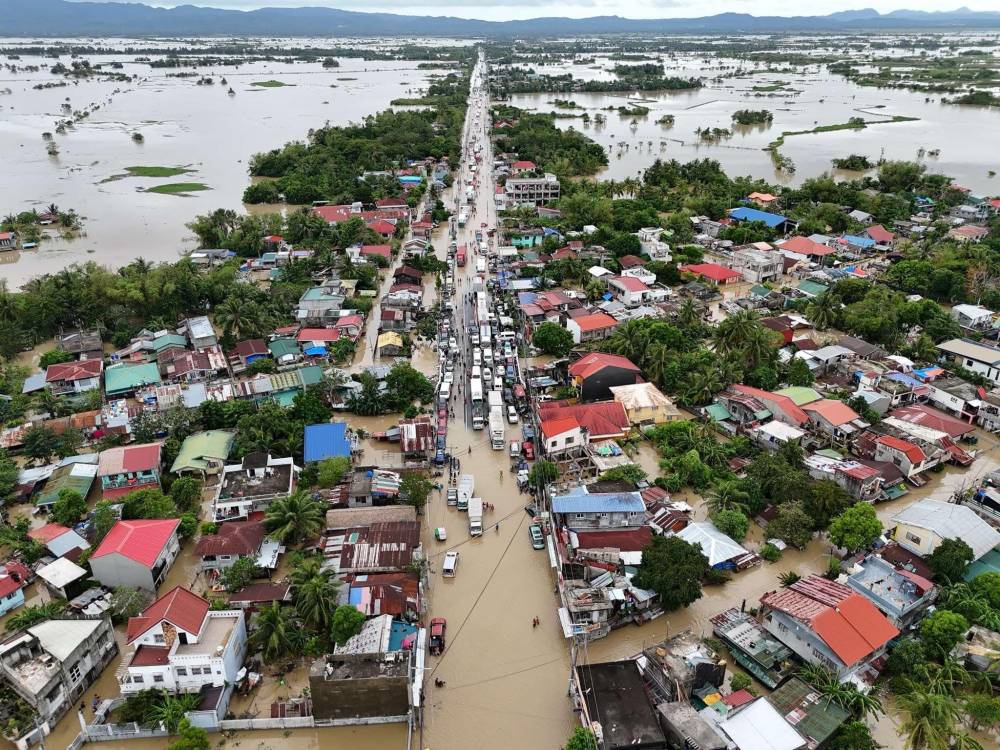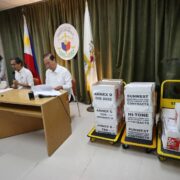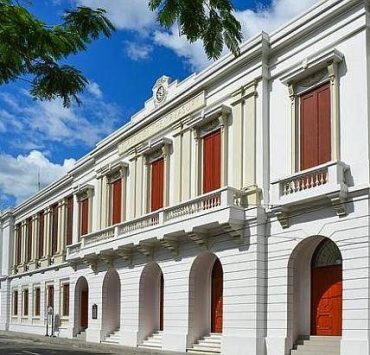Bus trips to Bicol halted to prioritize transport of goods to flood-hit areas

LEGAZPI CITY—Trips of public utility vehicles between Bicol and Metro Manila were temporarily suspended on Sunday by the Land Transportation (LTO) due to heavy traffic and delays of the delivery of basic supplies and goods to flood-hit areas, mostly in Camarines Sur and Albay.
The flood along the Maharlika Highway in the San Fernando-Milaor section and Nabua proper, all in Camarines Sur, has receded but most of the main roads were still submerged in at least one meter of water, said Vincent Nato, assistant director of the LTO in Bicol.
With the suspension of bus trips, trucks and other heavy vehicles bringing aid to Camarines Sur and Albay could now get through faster.
He asked the private vehicles to also refrain from traveling to Naga City to avoid congestion and not contribute to delays as a new weather disturbance, Tropical Storm “Leon” (international name: Kong-rey), was also threatening the region with possible heavy rainfall.
On Saturday, hundreds of vehicles were queuing in the 30-kilometer stretch of the highway in the province, according to reports reaching the LTO.
By Sunday, most of the trucking vehicles were still stranded while some were moving slowly along the flooded and congested highway from Camarines Sur.
Supply monitoring
Joseph Rañola, the assistant director of the Department of Trade and Industry (DTI) Bicol, said they have asked authorities to prioritize the trucks carrying basic goods, amid reports that some residents of Camarines Sur, including those from badly hit Naga City, were buying goods in Legazpi City in Albay province, as most businesses in their areas were still not operating.
According to Rañola, supply of food and basic needs in Camarines Sur were still adequate, except for bread. The agency also made sure of the price freeze of basic necessities, including canned sardines, processed milk, coffee refills, laundry detergents, candles, iodized salt, locally manufactured instant noodles, bottled water and bread, he added.
If the flow of goods was still hampered after a week starting this Monday, the DTI would ask manufacturers to find other routes to transport their goods, he said.
“Not only (Camarines Sur, Camarines Norte, Albay and Sorsogon) are affected, the Eastern Visayas region was also dependent on these roads [in Camarines Sur],” Rañola said in a phone interview on Sunday.
Impact
The Office of Civil Defense (OCD) Bicol said that as of Sunday morning, 118 roads and bridges in the region were still impassable to all types of vehicles due to flooding.
OCD Bicol spokesperson Gremil Alexis Naz said 495 villages in Albay and Camarines Sur were still heavily flooded while flood has subsided in 400 others.
As of Sunday, 53,876 families or 247,652 people were still in evacuation centers, said Naz.
The death toll in the region also reached 40 as of 3 p.m. on Sunday, with 20 others injured and three still missing, the Bicol police said.
Still to recede
In a flood bulletin issued at 9 a.m. on Sunday, the Bicol River Basin Flood Forecasting and Warning Center of the Philippine Atmospheric, Geophysical and Astronomical Services Administration said the waters at its Bula, Camaligan and Lake Buhi stations, all in Camarines Sur, remained at flood level but expected to gradually recede until noon.
The farmers’ group Kilusang Magbubukid ng Pilipinas on Sunday urged the government to halt quarrying activities in Bicol, noting the region is already susceptible to typhoons because of its location near the western Pacific area.
The group also said the quarrying around Mt. Mayon in Albay had stripped the natural embankments in the area, leading to higher flood risks during heavy rains, and loosened volcanic debris around the volcano, causing lahar flows or mudslides during heavy rains.
“While local governments argue that quarrying supports the economy by providing sand, gravel and ash for construction projects nationwide,” it carries “dangerous environmental risks” which are amplified by extreme weather events, according to the group.
East Visayas normalizes
In Eastern Visayas, the 4,299 families, composed of 14,528 people, who were sheltered at the height of floods caused by Severe Tropical Storm “Kristine” (international name: Trami) returned to their respective homes on Sunday after floodwater subsided, said Lord Byron Torrecarion, OCD director in the region.
Power and communication lines that were affected by the storm have been restored across the region, especially in the provinces of Samar, Eastern Samar, and Northern Samar, he added.
The extent of the damage to agriculture in Eastern Visayas was still being assessed.
Power restored
In Lanao del Norte, power has been restored to most of the province that also suffered from heavy rains spawned by the through of the storm.
However, 21 villages in Iligan City were still without electricity that was cut off on Friday after heavy rains and a whirlwind downed trees.
Danilo Bagtasos, spokesperson of the Iligan Light and Power Inc., said some hinterland barangays in the city remained isolated and without power as most of their personnel were still involved in the ongoing clearing operations at the city proper. They hoped to restore power in all areas in three days, with help of volunteers in the clearing operation, including soldiers from 503rd Engineering Battalion based in Iligan.
Roy Secuya, operations officer of the Lanao del Norte Provincial Disaster Risk Reduction Management Office, said most of the 462 villages in the province, particularly those located along the national highway, had been cleared of debris.
But officials in the province were also on alert as Leon has just entered the country and could also affect certain areas of Mindanao. —WITH REPORTS FROM GILLIAN VILLANUEVA, JOEY GABIETA AND RICHEL V. UMEL

















